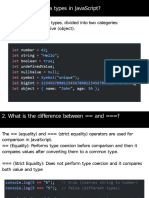0 ratings0% found this document useful (0 votes)
1 viewsAdvanced JavaScript Questions Full
The document contains 50 advanced JavaScript questions along with detailed answers covering key concepts such as variable declarations, closures, the event loop, promises, and asynchronous programming. It explains differences between various JavaScript features like 'var', 'let', and 'const', as well as function declarations versus expressions. Additionally, it discusses advanced topics like memoization, generators, and the use of weak references in data structures.
Uploaded by
sujeetnangareCopyright
© © All Rights Reserved
We take content rights seriously. If you suspect this is your content, claim it here.
Available Formats
Download as PDF, TXT or read online on Scribd
0 ratings0% found this document useful (0 votes)
1 viewsAdvanced JavaScript Questions Full
The document contains 50 advanced JavaScript questions along with detailed answers covering key concepts such as variable declarations, closures, the event loop, promises, and asynchronous programming. It explains differences between various JavaScript features like 'var', 'let', and 'const', as well as function declarations versus expressions. Additionally, it discusses advanced topics like memoization, generators, and the use of weak references in data structures.
Uploaded by
sujeetnangareCopyright
© © All Rights Reserved
We take content rights seriously. If you suspect this is your content, claim it here.
Available Formats
Download as PDF, TXT or read online on Scribd
You are on page 1/ 2
50 Advanced JavaScript Questions with Detailed Answers
1. What is the difference between var, let, and const?
var is function-scoped and can be redeclared; let is block-scoped and cannot be redeclared; const is
block-scoped and immutable after initialization.
2. What is closure in JavaScript?
A closure is a function that retains access to its lexical scope even when executed outside that
scope.
3. What is the event loop in JavaScript?
The event loop is a mechanism that handles asynchronous operations by pushing callbacks from
the event queue to the call stack.
4. What is hoisting in JavaScript?
Hoisting moves variable and function declarations to the top of their containing scope before
execution.
5. What is the difference between == and === in JavaScript?
== checks for value equality with type coercion, whereas === checks for both value and type
equality.
6. What is a Promise in JavaScript?
A Promise represents a value that may be available now, or in the future, or never, and it has states:
pending, resolved, or rejected.
7. What are async and await in JavaScript?
async makes a function return a Promise, and await pauses execution until the Promise resolves.
8. What are arrow functions, and how are they different from regular functions?
Arrow functions have a shorter syntax and do not have their own this, arguments, or prototype.
9. What is the difference between null and undefined?
null is an assigned value representing no value, whereas undefined means a variable has been
declared but not assigned a value.
10. What is the difference between function declaration and function expression?
Function declarations are hoisted, whereas function expressions are not.
11. What is the difference between call, apply, and bind?
call invokes a function with a specific 'this' and arguments, apply is similar but takes an array of
arguments, and bind returns a new function with 'this' set.
12. What is an IIFE (Immediately Invoked Function Expression)?
An IIFE is a function that executes immediately after its definition, often used to create a local
scope.
13. What is a higher-order function?
A higher-order function is a function that takes another function as an argument or returns a
function.
14. What is the difference between spread and rest operators?
The spread operator (...) expands elements, whereas the rest operator (...) collects them into an
array.
15. What is debouncing and throttling?
Debouncing delays execution until after a pause in activity, whereas throttling limits execution to a
fixed rate.
16. What is the difference between shallow and deep copy?
A shallow copy copies object references, whereas a deep copy clones objects recursively to avoid
reference issues.
17. What are JavaScript generators?
Generators are functions that can be paused and resumed using the 'yield' keyword.
18. What is the difference between synchronous and asynchronous programming?
Synchronous code executes sequentially, whereas asynchronous code allows non-blocking
execution using callbacks, promises, or async/await.
19. What is memoization in JavaScript?
Memoization is an optimization technique that caches function results to improve performance.
20. What are weakMap and weakSet in JavaScript?
WeakMap and WeakSet store weakly referenced keys, allowing garbage collection when keys are
no longer needed.
You might also like
- Java: Programming: Your Step by Step Guide to Easily Learn Java in 7 DaysFrom EverandJava: Programming: Your Step by Step Guide to Easily Learn Java in 7 Days4/5 (30)
- JavaScript mulakat - interview QuestionsNo ratings yetJavaScript mulakat - interview Questions8 pages
- 50 Javascript Interview Questions Part 1No ratings yet50 Javascript Interview Questions Part 155 pages
- 100 Most Asked JavaScript Interview QnANo ratings yet100 Most Asked JavaScript Interview QnA14 pages
- JavaScript Interview Questions With AnswersNo ratings yetJavaScript Interview Questions With Answers18 pages
- Javascript Interview Question PDF by Relaxbyte WatermarkNo ratings yetJavascript Interview Question PDF by Relaxbyte Watermark6 pages
- Javascript Interview Questions and AnswersNo ratings yetJavascript Interview Questions and Answers19 pages
- Javascript questions for interview preparationNo ratings yetJavascript questions for interview preparation17 pages
- Basic_JavaScript_Interview_Questions_AnswersNo ratings yetBasic_JavaScript_Interview_Questions_Answers3 pages
- ? ? Top 55 JavaScript Interview QuestionsNo ratings yet? ? Top 55 JavaScript Interview Questions18 pages
- Javascript Interview Questions and Answers PDF FreeNo ratings yetJavascript Interview Questions and Answers PDF Free20 pages
- Top 100 JavaScript Interview Questions and AnswersNo ratings yetTop 100 JavaScript Interview Questions and Answers29 pages
- Important questions asked in Js interviewsNo ratings yetImportant questions asked in Js interviews10 pages
- Kotlin at a Glance: Use of Lambdas and higher-order functions to write more concise, clean, reusable, and simple codeFrom EverandKotlin at a Glance: Use of Lambdas and higher-order functions to write more concise, clean, reusable, and simple codeNo ratings yet
- Mastering Java Concurrency: From Basics to Expert ProficiencyFrom EverandMastering Java Concurrency: From Basics to Expert ProficiencyNo ratings yet
- Assignment On Classes and Objects - QuestionsNo ratings yetAssignment On Classes and Objects - Questions2 pages
- C++ Programming MCQs Test 3 _ Online C++ Programming Test - StudytonightNo ratings yetC++ Programming MCQs Test 3 _ Online C++ Programming Test - Studytonight8 pages
- Data Structures - Unit 4 Stack and QueueNo ratings yetData Structures - Unit 4 Stack and Queue199 pages
- Intelligent Techniques On Robbotic RestaurantsNo ratings yetIntelligent Techniques On Robbotic Restaurants34 pages
- Javascript - Using Async - Await With A Foreach Loop - Stack OverflowNo ratings yetJavascript - Using Async - Await With A Foreach Loop - Stack Overflow40 pages
- Pointers and References in C++ Fifth Step in C++ LearningNo ratings yetPointers and References in C++ Fifth Step in C++ Learning139 pages
- Object-Oriented Programming Lab 3: Arrays Class, String ClassNo ratings yetObject-Oriented Programming Lab 3: Arrays Class, String Class5 pages
- Introducing Classes, Objects, and MethodsNo ratings yetIntroducing Classes, Objects, and Methods83 pages

























































































